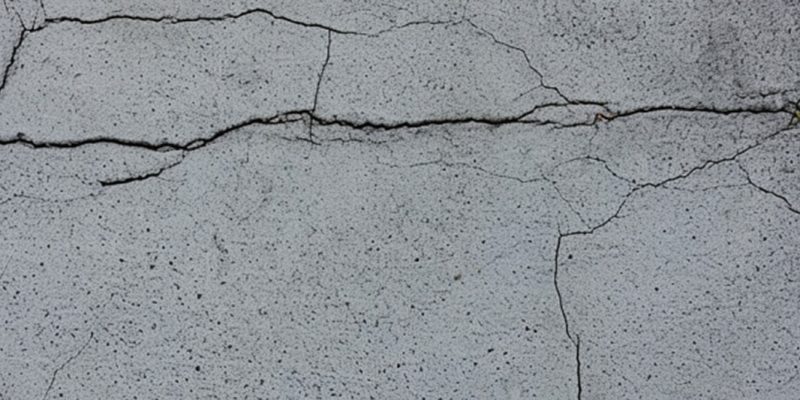Hello Des Moines homeowners! Today, we’re diving into something you might have noticed on your driveways or sidewalks – those fine lines on the concrete known as crazing. It’s not just about looks; understanding crazing is key to keeping your concrete in top shape. Let’s break down what it is, why it happens, and how to deal with it.
What is Concrete Crazing?
Ever noticed those tiny, spider-web like cracks on your concrete surfaces? That’s concrete crazing. Think of it like wrinkles on clothes – they don’t necessarily mean damage, but they’re definitely noticeable. Crazing happens when the top layer of your concrete dries faster than the rest. It’s like when the top of a cake dries out faster than the inside. These cracks are super thin, usually not more than a hair’s width, and they create a sort of map or network pattern on the surface. While they might catch your eye, these little lines aren’t usually a sign of serious trouble. They’re more about the look of the concrete rather than its strength. Still, knowing about them helps you understand what’s going on with your concrete paths or patios.
Should I Worry About Concrete Crazing?
Now, you might wonder, “Should I be worried about these little lines?” In most cases, crazing is more about looks than a safety hazard. These tiny cracks don’t typically mean your concrete is falling apart. It’s more like finding gray hairs – a sign of aging but not necessarily a health issue. However, if you’re all about keeping your driveway or walkways looking sharp, then paying attention to crazing matters. It doesn’t weaken the concrete, but it might not be the look you want. So, while it’s not a big worry, it’s something to keep an eye on, especially for how it looks.
Causes of Concrete Crazing
So, what makes these little lines show up? It’s a bit like baking – if conditions aren’t just right, you don’t get the perfect cake. With concrete, several things can cause crazing. First up, if the concrete dries too fast, especially on a hot day or in a breezy spot, you get crazing. It’s like when the top of your soil dries out faster than the bottom in the summer. Another cause is too much water in the concrete mix. Just like with cake batter, if it’s too runny, it doesn’t bake right. The same goes for concrete. Too much water means it won’t set properly.
Sometimes, it’s about how the concrete is finished. If the surface gets smoothed out too much, it can bring water up to the top. It’s a bit like over-kneading bread dough – it changes the texture. Lastly, not curing the concrete right can lead to crazing. Curing is like letting the concrete rest and gain strength. If it’s not done right, the concrete doesn’t develop as it should. All these factors – quick drying, too much water, overworking the surface, and improper curing – can lead to those little lines we call crazing.
Can I Remove Concrete Crazing?
You might be thinking, “Can I get rid of these lines?” Well, it’s not as straightforward as erasing a pencil mark. Once crazing has happened, it’s pretty much part of your concrete. It’s a bit like a scar – you can’t just wipe it away. But don’t worry, there are ways to make it less noticeable. You can’t really remove crazing completely, but you can work around it. Think of it as camouflaging an imperfection rather than erasing it. So, while you can’t make crazing disappear like magic, there are steps to reduce how much it stands out.
Steps to Remove Concrete Crazing
While we can’t completely erase crazing once it’s occurred, we can certainly make it less noticeable. Here are some more detailed steps you can take:
Seal it Up
Think of sealing as putting a protective layer over your concrete, much like a clear varnish on wood. A concrete sealer fills in those tiny cracks, making them less visible, and protects your concrete from further damage. It’s a simple process: clean your concrete, let it dry, and apply the sealer with a roller or sprayer. It’s like painting a wall – a bit of effort for a long-lasting effect.
Coloring or Staining
Adding color can really shift the focus away from the crazing. It’s a bit like using a stain on wood to enhance its look. You can choose a color that complements your home and apply it to the concrete. This not only hides the crazing but also gives your concrete a fresh, new look. It’s important to clean the concrete thoroughly first and then apply the stain following the product’s instructions.
Grinding
For a more hands-on approach, lightly grinding the concrete surface can help. It involves using a concrete grinder to smooth out the surface, which can reduce the visibility of crazing. This method is more labor-intensive and might change the surface texture of your concrete, so it’s often best left to professionals.
Resurfacing
If you’re up for a bigger project, resurfacing is like giving your concrete a completely new skin. This involves applying a new layer of concrete or a resurfacing product over the existing surface. It’s like putting a new icing layer on a cake. Resurfacing not only covers crazing but also allows you to refresh the entire look of your concrete area. Keep in mind, this is a more involved process and might require professional help.
Each of these methods has its own benefits and challenges. It’s about finding what works best for your concrete surfaces and your home’s overall look. Remember, while these methods don’t erase crazing, they do a great job of making it less noticeable and keeping your concrete looking its best.
Preventative Measures: How to Avoid Concrete Crazing
The best way to deal with crazing is to avoid it from the start. Here are some tips:
Watch the Weather: Pouring concrete on a super hot or windy day? That’s asking for trouble. It’s like leaving your cake in the sun – it’ll dry unevenly. Try to choose a mild, calm day for your concrete work.
Get the Mix Right: Just like with a recipe, the right mix matters. Too much water in your concrete is like too much milk in your pancakes – it won’t turn out right. Make sure your concrete has the proper balance of ingredients.
Smooth, but Not Too Much: When finishing your concrete, be smooth but not overly so. It’s like icing a cake – you want it even, but overdoing it can ruin the texture.
Cure it Properly: Let your concrete cure slowly and evenly. It’s a bit like letting bread rise – you can’t rush it. Cover it with plastic sheeting or wet burlap to keep the moisture in.
Use Quality Materials: Just like cooking with fresh ingredients, using high-quality concrete and additives can make a big difference. Cheap materials can lead to poor results.
By paying attention to these factors, you can greatly reduce the chances of crazing. It’s about being mindful and careful with your concrete, just like you would be with any other important project around your home.
Long-Term Care and Maintenance
Taking good care of your concrete is key to avoiding crazing in the long run. Here’s what you can do:
Regular Checks: Keep an eye on your concrete, just like you would with your garden. Look for signs of wear and tear, especially after harsh weather.
Clean Gently: When cleaning your concrete, be gentle. Harsh chemicals or high-pressure washing can do more harm than good, sort of like using a strong cleaner on a delicate fabric.
Reapply Sealant: Every few years, consider resealing your concrete. It’s like reapplying sunscreen – it provides protection and keeps it looking good.
Fix Small Problems Early: If you spot any issues, tackle them early. Addressing small problems before they grow is always easier, much like dealing with a weed in your yard before it spreads.
By following these simple care tips, you can help your concrete stay strong and look great for years.
Conclusion
So, there you have it, folks in Des Moines – everything you need to know about concrete crazing. Remember, it’s more about keeping your concrete looking good than a big worry. With the right care and attention, you can manage crazing effectively. Here’s to enjoying smooth and beautiful concrete surfaces in our homes!

